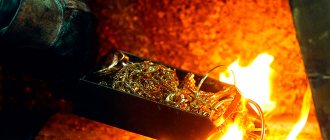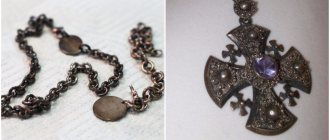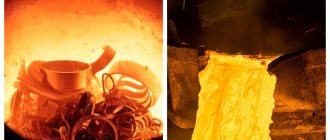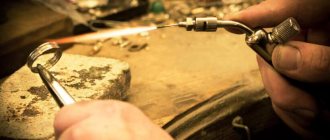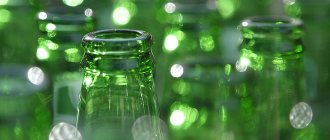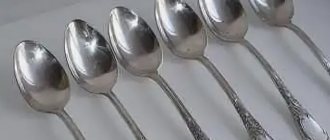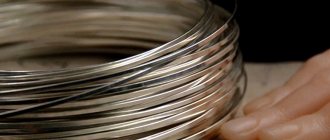Silver is used not only in jewelry, but also in industry, due to the physical and chemical properties of this metal. Therefore, many are interested in such qualities as the melting point of silver, its thermal conductivity and resistance. Silver can be found in microcircuits, resistors, relays, and batteries. This metal is used more often than gold because silver is cheaper and easier to mine.
Cleaning silver jewelry with baking soda
Silver as a metal: physical and chemical properties
The purest silver is a malleable and fusible element that is part of the group of precious metals. This group includes gold, platinum, and five other platinum-class metals.
All noble elements share a unique property - they remain inert when interacting with various air, liquid and gaseous media, leading to corrosion and oxidation. Lunar metal retains its natural shine when exposed to carbon dioxide. Under normal conditions, it reacts with sulfur to form silver sulfide.
In its pure form it is heavy, its density is estimated at 10.5 g/cm3. It is slightly lighter than lead, but heavier than copper. Capable of maintaining geometric dimensions and surface properties when heated, while possessing wide capabilities for changing shape.
Among other things, the precious metal is famous for its disinfecting properties.
Remelted silver bars
Melting and boiling points of silver: main factors
To melt the precious metal, a temperature of 962 °C or 1234.15 kelvin is required.
Boiling point is 2212 °C or 2485.15 kelvin.
This is the point after which a liquid body begins to transition to the gaseous stage.
Why melt silver
Many people do not suspect that precious metal surrounds us everywhere. About 80% of global silver production comes from the industrial sector, with the remainder from banks and jewelry.
Lunar metal is found in radio components, batteries, contacts, capacitors, coins, cutlery, and jewelry. Even the average user's computer or laptop contains about 1 gram of precious metal.
By melting silver, you can create an analogue of a bank ingot or a unique dyeing with your own hands. If you have accumulated a lot of silver items at home that can no longer be useful, you should not rush to throw them away.
Application area
Affordable cost, ductility and ease of processing allow the metal to be used in industry and everyday life. The most common applications are as follows:
- production of jewelry, various decorations in combination with other metals, precious and semi-precious stones;
- production of original tableware;
- multilayer ceramic capacitors, relay contacts;
- as part of the cathodes of galvanic cells;
- minting of coins, special awards, orders;
- application in climate control in an alloy with silver iodide;
- as a coating for original handmade mirrors;
- as a catalyst in oxidation reactions.
In addition, humanity discovered the disinfecting properties of metal several centuries ago. In Ancient Rome and Persia, water was stored in silver vessels for important gentlemen, military men, and soldiers.
It is worth noting that in jewelry they often used not pure material, but its alloy with copper or other types of raw materials. It was then that the craftsmen began to be interested in the topic of melting silver at home, because most of them worked at home.
Fireproof laboratory crucible or asbestos melting mold
Melting silver is impossible without a fireproof vessel or crucible. A crucible is a container for heating, firing, and drying various materials. It usually has a conical or cylindrical shape. The melting mold of asbestos is one of its varieties.
Asbestos is a chemically resistant material that can withstand temperatures up to 1900 °C. If there is no crucible, you can take a spoon and cover it with asbestos sheets, and then with flux.
You can buy a crucible in a store from 100 rubles apiece. Choose those that can withstand temperatures of 1000 degrees. The crucible resource is usually enough for 50 melts.
Before starting work, it is best to place the asbestos under a fireproof container for additional protection. This way you can avoid fire hazards.
Forceps
To work, you need to purchase heat-resistant tongs or tweezers. They are used to grip a crucible to pour the molten precious metal into a prepared mold where it will solidify.
The cost of heat-resistant tools is from 350 rubles.
Melting silver at home
Metal spoon
You can make a mini-smelter from an ordinary spoon by covering it with asbestos sheets. Next, the spoon needs to be coated with flux, which is sodium tetraborate. This is necessary so that the precious metal does not react with air when melting.
Important! Sodium tetraborate is a pharmaceutical borax. It not only prevents oxidation, but also helps the liquid base flow over the sides of the crucible.
Melting charge
A mixture is a mixture of melted metal and borax.
In order for the precious metal to quickly transition from a solid to a fluid state, silver elements are first broken into small pieces. Then they are mixed with borax in a ratio of 10 to 1 part sodium tetraborate.
Pliers
You will need pliers to break the silver elements into smaller pieces. Another tool that is also suitable for this purpose is pliers.
Magnet
Silver alloys are compounds of precious metals with various impurities. To extract particles of iron alloy from the material, you need to use a magnet.
Silver with impurities
If the alloy is not cleaned in this way, then in the future the metal will heat up unevenly, and it will take longer to transition to the liquid state.
Powerful step-down transformer with an output voltage of 25 V
The transformer is used as the main element of the melting device.
Preparation for the procedure
In production conditions, it is not difficult to ensure a suitable melting temperature for silver. The workshop is usually equipped with special stoves, gas, casting molds, tools, and fireproof stands. Personnel are provided with clothing made from materials that are not subject to fire.
The process has a high fire hazard, so if you try to melt any product at home, it is recommended to carefully prepare. It is extremely rare for an amateur to perform a procedure with a large amount of silver. Typically, antique jewelry or parts thereof, massive, torn chains, large pendants or earrings that do not have a pair are used.
You can melt such material at home with proper preparation of the room. It is important to ensure good ventilation, preferably forced ventilation. This will allow the vapors to quickly evaporate, and the person will not inhale harmful substances. It is necessary to prepare the following items:
- steel container in which the products will be located;
- a special form into which the material will be poured after melting;
- protective clothing, face mask, goggles, fire-resistant gloves;
- gas or gasoline burner;
- asbestos sheet;
- professional tongs.
To work with hot metal, special suits are usually worn. It is recommended to protect your eyes with glasses that fit tightly to the skin; it is better to additionally protect your face with a mask. During melting, contact with a hot spark on the skin or cornea will certainly lead to a severe burn.
Tongs allow you to eliminate direct contact of human hands with the molds and container where the material will melt. Some carry out the procedure in the kitchen.
It is recommended to remove all flammable items. Experts advise setting aside a separate room for such manipulations, for example, a garage or workshop.
Melting scrap silver using various devices at home
So how do you melt silver? The algorithm of actions will be approximately the same for any method. The transition from one step to another must be carried out strictly in order.
- First, a melting pot is prepared, which is a crucible or spoon treated with pharmaceutical borax.
- Silver parts are loaded into the smelter.
- Now the materials are heated to a liquid state.
- The resulting liquid filling must be poured into a pre-prepared cast iron mold.
Important! On the eve of the process, it is better to separate the precious metal by degree of purity. Material from different samples will have different combustion temperatures.
Melting silver on a gas burner
Knowing at what temperature silver melts, you can begin the process itself. Home casting involves the following steps:
- Precious metal must have a high degree of purity to work. The ideal option is 999, 960, 925 markings.
- Prepare a crucible from fire-resistant materials.
- Pre-obtain a form for low tide. You can make it yourself or buy it in a specialty store.
- Metal that has been cleaned or broken into small particles can begin to be melted. The burner should be at a distance of 3-5 centimeters from the material.
- After the final transition of the precious metal into a liquid state, it must be poured into the prepared mold. This needs to be done as quickly as possible, but carefully. The base, ready for casting, resembles a drop of mercury. It should remain inside the mold until completely hardened.
- After crystallization of the precious metal, it must be removed from the mold, then placed under a stream of ice water. If the silver does not separate from the mold, after cooling it is removed by hand.
Important! When using the burner, you must carefully monitor the flame. It should be soft so that the flux does not fly apart.
Melting scrap silver
Melting in the microwave
This method is not only safe, but also the fastest. The oven power must be at least 700 W.
General information
Metal has been known to man since ancient times. Silver scrap was considered a strong and durable device, which ancient people learned to make even before our era. In addition, the material was often found in its native form; there was no need to melt ores to extract pure raw materials. Despite information from history claiming that ancient people did not know how to properly handle metal, today archaeologists find many household items and weapons made before our era.
The cultural traditions of different peoples differed, but many revered precious raw materials as a symbol of the moon. The population of Babylon and Assyria considered it to be a sacred metal. In the middle of the 12th century, most alchemists used the material in their experiments, which was possible due to its unique chemical properties.
Today, raw materials are mined in large quantities in Canada, Sweden, the USA, Russia, Kazakhstan, Norway, the Czech Republic and Slovakia. Many deposits make it possible to sell finished products at an adequate price. There is no shortage of metal today.
Precautions for smelting operations
Foundry processes require increased safety precautions. There should be no flammable substances near the isolated work area. You should not skimp on protective equipment; you should definitely purchase glasses with protective glass on a garter, an apron, gloves, and work clothes.
Clothing must cover the entire body, since even a drop of hot precious metal can burn a section of skin to the bone.
You can also purchase a fire extinguisher to prevent a fire.
Homemade silver smelting
Cleaning silver from impurities yourself
The procedure for removing impurities is called refining. Using refining you can clean:
- Scrap of high-grade precious metal products;
- Technical silver;
- Waste from electrical cleaning;
The refining process should take place in a room with a powerful hood or outside. Substances harmful to humans will be released into the air.
To clean silver from impurities, you can place the material inside a liter jar and fill it halfway with nitric acid. The reaction will be manifested by heat and a pronounced bitter odor.
You will need to wait until the essence has cooled completely. Next, a saline solution is added to the container. As the reaction progresses, the precious metal chloride will settle to the bottom.
Now you need to pour running water into the jar. When the sediment sinks to the bottom again, the surface water layer is drained. The action is repeated several times until the essence becomes completely transparent.
Important! For 100 g of processed material, 250-350 ml of each reagent are needed.
A fairly common cleaning method is electrolysis. This refining is based on the characteristics of a smooth electric current. Silver parts act as the anode, and a silver plate acts as the cathode.
For the electrolysis method you will need:
- DC transformer;
- Clamps;
- Vessel with electrolyte (silver dissolved in nitric acid);
Category: question-answer
Is it possible to mix silver of different grades for melting?
Expert opinion
Andrey Seleznev
Chemist-technologist, Volgograd
It must be taken into account that different samples will have individual melting points. It is much easier to melt silver of the same purity, because then the metal will react equally to all processes. It is recommended to clean it from the ligature in advance by chemical or electrolysis.
Is it legal to melt silver at home in the kitchen?
Expert opinion
Pribrezhny Gennady Valentinovich
Jeweler 6th category
Activities for processing scrap and waste of precious metals are subject to licensing in accordance with the legislation of the Russian Federation. Illegal mining may result in an administrative fine. Article 15.44 of the Code of Administrative Offenses states: the fine will be one or one and a half times the cost of the materials that are the subject of the offense.
If you try to sell the resulting bullion to buyers, you may face criminal liability.
Which silver sample melts the easiest?
Expert opinion
Pribrezhny Gennady Valentinovich
Jeweler 6th category
The lower the standard of the precious metal, the easier it will melt. For example, the melting point of 925 silver differs from 875 by 130 degrees upward. Of the most common markings, the lowest melting range is 800 - from 780 °C and above.
Can silver be melted down into elegant home decoration?
Expert opinion
Grishanov Mikhail Petrovich
Jeweler, director of the Grishanov and Co. workshop
You can buy or make your own mold for casting simple jewelry, for example, a simple ring or pendant. However, to make filigree items yourself requires not only special skills, but also specialized equipment.
Metal characteristics and melting point
Silver is more than 6,000 years old, as evidenced by archaeological finds in Turkey, Egypt and Iran. The second name of the precious metal is lunar, because according to esotericists, it is this luminary that serves as his patron, and the color resembles the cold shine of the Moon. In the past, this noble metal was valued more than gold.
Silver is characterized by the following physical properties:
- density - 10.6 g/cm3;
- hardness - soft and ductile;
- fusibility - high;
- thermal conductivity is the highest;
- electrical conductivity is the highest;
- reflectivity - yes.
The melting point of silver is 750-760 degrees
Having decided to smelt silver yourself, you need to know the temperature at which the metal changes from a solid state to a liquid state. It depends on the amount of foreign impurities in the composition. If the silver alloy includes a small amount of alloys, then its melting point will not exceed 750-760 degrees. The raw materials used in smelting are called charge. It is heated according to certain rules, taking into account the technological process, as well as observing safety precautions.


